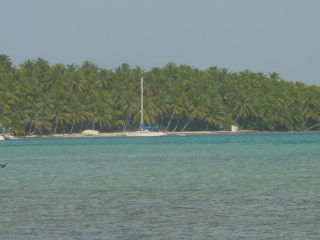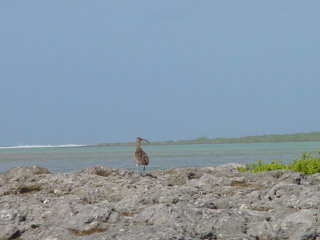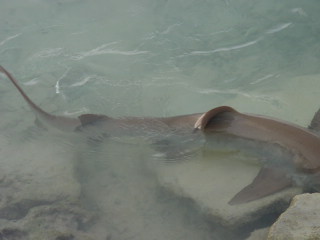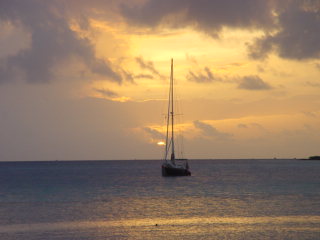Suwarrow
As we left Bora Bora, we decided to make a small detour and stop at Suwarrow atoll, in the Cook Islands.
Seven days to sail 700 miles, rather lumpy seas, no possibility of a night entrance to the lagoon and therefore having to slow down for 18 hours (very difficult in Flame) all made for a rather trying journey. You first see an atoll about 9 miles off if you are lucky. The sound of waves breaking on the reefs makes one worry. At first light we find another yacht awaiting the dawn to enter. The plotted position of the entrance seems strange (the wreck of a trawler of the reef gives a stern reminder to take care). Find the line, palm trees to starboard, raging surf just to port – is there a gap in the breakers? The depth starts to shallow 6 fathoms, 5, 4, 3 … 2.2 (we draw 1). The clear water tests one’s nerve – abort? go about? no, go on and into the relative peace of the lagoon.
|
|

|
Imagine the lagoon: circular and 10 miles in diameter; nearby our motu – Anchorage Island - about 100 yards long, stretching out to starboard with a long sandy beach in front, the coconut palms waving at us; a rough stone jetty coming out from the shallows for about 70 – 100 feet. The recommended anchorage is deep – 6 or 7 fathoms – with coral heads but also sandy patches. We try to drop the anchor on sand – it’s a long way down to free the anchor if it catches in a coral head. The chain runs out, we reverse, the anchor holds. There are a few other yachts in the anchorage. To port the reef, now covered, runs around us for half a mile to another motu without palm trees. The sea is coloured from dark blue to light blue to brown where the coral is near the surface. And underneath, as we later discover, a coral garden with water so clear you might imagine there is no water, just air, and many coloured fish.
|
|

|
Completing our jobs, we take the dinghy ashore, stop alongside the jetty, very unsteady and difficult to walk on, and up the beach littered with coconuts to a small clearing with a massive table supported on four big coconut tree legs. Tom and John the new wardens appear. Tom is about 60 and upright, John smaller and 69, both are very friendly. The only formalities are to sign the book, though we have not formally entered the Cook Islands. (There are 15 small atolls, spread over an area about 1500 by 1000 miles). “You’re welcome – we have only recently arrived ourselves,” says Tom, “make yourselves at home – barbecued fish tonight!” and after a brief chat we walk through the coconut and breadfruit trees down an old path lined with stones towards the windy seaward side of the motu near the entrance and back round the reef to the sheltered anchorage side.
|
|
In Suwarrow, we had our first insight into how it is possible to live and be self-sufficient on such an atoll. Though Tom and John, as wardens on behalf of the Cook Islands government, have a monthly visit from a patrol boat which brings them supplies, they also are using their traditional knowledge and skills, combined with some modern assistance, to press the indigenous plants and fish into service, and not only for food. The barbecue consisted of fish caught by John, free diving with a spear gun, catching enough fish in 10 minutes under one of the yachts to feed some dozen of us well, and breadfruit picked from one of the trees, and baked in the fire, served on banana leaf plates and eaten with the fingers – and absolutely delicious!
During the evening John (the warden) vanished into the wood behind and returned with a large coconut crab, which has strong enough claws to be able to crack a coconut, in his bare hands. The following day, the yachtsmen gathered to help the wardens turn over their very heavy fibreglass dory which had been holed, in order to repair it. One of the yachtsmen was skilled in fibreglassing, and though he had epoxy, he had no mat, so Tom suggested using the fibre from the outside of a coconut. The boat had been rolled up the beach on coconut tree rollers, then John (the warden) had climbed up one of the coconut trees to tie a block from one of the yachts at the right height to give a purchase to help us turn the dory over, and finally it was supported by longer coconut tree props.
Going ashore during the day, drinking coconuts were on offer – these are the young, still green coconuts, which have to be picked by climbing a tree and which have clear “water” inside them, which is most refreshing and thirst quenching to drink, and quite unlike the milk we find inside a coconut won at a shy at home. The flesh is soft and juicy too. They provide a ready supply of safe drinking “water” wherever there is a coconut palm, and someone able to climb it.
|
|
Rain water is collected from the roofs of the wardens’ house and shed, and stored in underground cisterns. There is no ground water on the island, but the collected rain water provides enough for two, used sparingly. Most washing needs are met with sea water, so clean and close by.
We had asked about bird watching and been directed over to the motu at the other side of the anchorage. The vegetation here is quite different from the warden’s island – no palms, but low scrubby trees – a type of ironwood, we were told – providing excellent roosting and nesting sites. Hundreds of birds wheeled around, investigating us, quite unafraid, so that we had a wonderful view as they flew over. There were boobies – brown, blue footed, and red-footed, and many types of tern, all practising diving at us. Frigate birds flew higher and there were many tropic birds, which are all white, with incredibly long thin tail feathers which more or less double their overall length.
|

|
We sat down near the edge of the reef to watch them all, and a curlew landed close by and allowed us watch it for some minutes and to take its picture. We spotted a bright white shape in the scrub several hundreds of yards away and walked over for a closer look – it was a booby chick, on its nest, its visibility from so far away clearly demonstrating the lack of predators. It too allowed us close enough for a photo, looking down at us rather crossly at the intrusion, and looking rather like a demented old lady with its frizzy white hair.
|
|
Going ashore that evening, we saw a wonderful display of the frigate bird’s agility and control. These are large birds (with a wingspan of four to five feet) whose feathers are not waterproof so they cannot land on water, and we watched one scooping up fish with its beak, flying low above the water, dipping down to pick up a fish, then up and clear, then down again, and so on - four or five times in a row.
We spent some time in the water snorkelling. There were lovely coral-coloured coral trout; very pretty tiny pale blue fish swimming round a pink-branched coral; a 2-foot long trumpet fish which was translucent with black stripes when we first saw it, but lost its stripes before our very eyes as we approached it; small horizontally striped fish clearly cleaning and grooming other larger fish; a goat fish, and many, many others. The colours are often so startling that they seem totally unbelievable, and many of the fish look like cartoon characters, with exaggerated “eye makeup” and apparent large smiles. There are many large clams here, with varied lip colours – bright purple, turquoise, blue, and coral pink.
|

|
The following day we went out to the reef just inside the entrance, and having made sure the current was flowing gently in, swam above a smallish white tipped shark, which seemed to be herding the parrot fish below, though not attacking them. We went on into the entrance, hanging on to the dinghy as it as too deep to anchor, where a large (4 foot long) black tipped reef shark swam past and then circled us, getting gradually closer. If it comes out, we should have an underwater photo of him “full frontal” approaching us. When we saw Tom later, he pursed his lips on hearing about the white tipped shark – they are not normally all that friendly, so perhaps we were lucky that that was the small one!
|
On our last day, swimming round the boat to clean off the hull before the next passage, and scraping off the (thankfully few) barnacles spread around, several black-tipped reef sharks appeared from deep below us, circling gradually higher towards us to investigate the potential for food. Scraping off weed bored them, and they circled slowly back down again, until the next few barnacles, which brought them slowly but determinedly back! Fortunately it only took three short dives to clear the barnacles and they lost interest again. But the largest was again four feet or so, and it is not a great incentive to carry on with hull cleaning! We had earlier seen several small sharks gathered for a feast when the fish for the barbecue were being cleaned on the jetty.
We left wishing we had the time to stay for longer, but delighted that we had stopped, instead of going straight to Samoa as originally planned.
|
|
John & Helen
Fleming
Flame of Gosport
20 September 2001
|

|
 |
Return to Home Page |
 |
Next
bulletin - 9th October 2001 |
 |
Previous bulletin -
30th August 2001 |